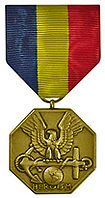Navy and Marine Corps Medal
| Navy and Marine Corps Medal | |
|---|---|
 | |
| Type | Medal |
| Status | Currently awarded |
| Established | 7 August 1942 |
 Navy and Marine Corps Medal ribbon | |
| Precedence | |
| Next (higher) | Distinguished Flying Cross |
| Equivalent | Army - Soldier's Medal Air Force - Airman's Medal Coast Guard - Coast Guard Medal |
| Next (lower) | Bronze Star |
The Navy and Marine Corps Medal is the second highest non-combatant medal awarded by the United States Department of the Navy to members of the United States Navy and the United States Marine Corps. The decoration was established by an act of Congress on August 7, 1942.
The Navy and Marine Corps Medal may be awarded to service members who, while serving in any capacity with the Navy or Marine Corps, distinguish themselves by heroism not involving actual conflict with an enemy. Typically, it is awarded for actions involving the risk of one's own life.
During the mid 20th century, the Navy and Marine Corps Medal has been awarded instead of the Silver or Gold Lifesaving Medal, for sea rescues involving risk of life. This is due primarily to the creation of a variety of additional military decorations that are often considered more prestigious than the Lifesaving Medal.
The Navy and Marine Corps Medal was first bestowed during the Second World War, although the first recipient is unknown. A famous recipient of the Navy and Marine Corps Medal was President John F. Kennedy who was awarded the Navy and Marine Corps Medal for service as Commanding Officer of a World War II Motor Torpedo Boat PT-109.
The Navy and Marine Corps Medal is generally considered the equivalent of the U.S. Army Soldier's Medal, the U.S. Air Force Airman's Medal, and the Coast Guard Medal.
See Also: Awards and decorations of the United States military, Lifesaving Medal
Notable Recipients
